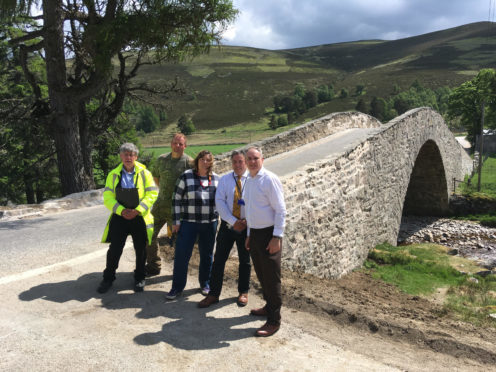Two politicians have demanded a long-term solution to protect a vulnerable historic bridge.
Gairnshiel Bridge, on the A939 Ballater to Tomintoul road, has been beset with problems for years as heavy goods vehicles continue to ignore the 18-tonne weight limit.
The northern end of the 18th century bridge also lies at the end of a winding hill, meaning motorists sometimes misjudge on entering and collide with the structure.
Last week the bridge re-opened after a fortnight of repairs to make it safe to cross, however just days later another crash happened and Aberdeenshire Council’s roads team had to carry out emergency repairs.
When the route is closed it means motorists travelling from either direction have to take a 24-mile detour.
Now Aboyne, Upper Deeside and Donside Councillor Geva Blackett – who has been calling for action for years – has enlisted the help of Moray MSP Richard Lochhead to come up with a solution.
The pair met at the bridge, along with infrastructure boss Stephen Archer, roads manager Donald Macpherson and Invercauld Estate’s head game-keeper Hans McKenzie-Wilson.
Mrs Blackett said that any HGV drivers who flouted the weight limit, despite signs on the lead-up to the bridge, were treating the community with contempt.
She said: “If the 18-tonne lorries are still ignoring the weight limit they are sticking two fingers up at the council, the bridge but also the community because if it’s shut everyone is inconvenienced.”
Mr Archer has confirmed the authority is exploring a number of options to address the problem, including erecting a new bridge to give cars an alternative route.
Mr Lochhead said a long-term solution was critical for tourism to both Moray and Aberdeenshire.
He said: “I know Geva Blackett has been pushing this use for a number of years and we have been working together in partnership with Aberdeenshire Council to get this long-standing challenge addressed.
“By doing so we can continue to benefit from tourists visiting upper Speyside and those travelling to Donside, as well as to ensure the local population faced with any significant detours.”
